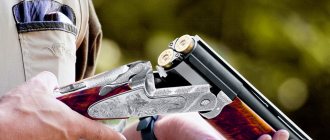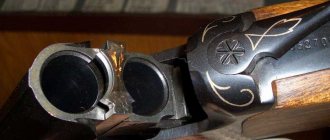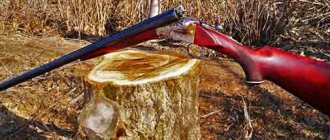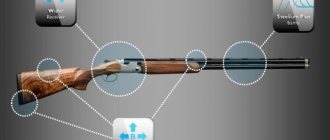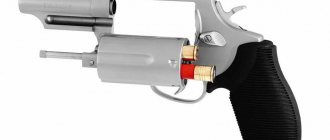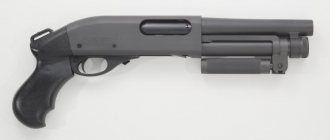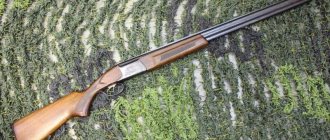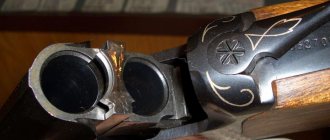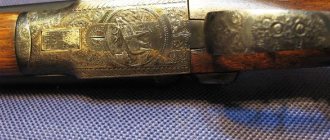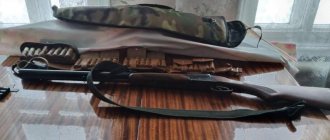- September 14, 2018
- Weapons and ammunition
- Valeria Antonova
Three-barreled shotguns are not the most common type of weapon in Russia, despite this, decent models of this series can be found in gun stores or secondary markets. What are the benefits of three-barreled shotguns, and what types are there? This and much more will be discussed in this article.
What is drilling? History of origin
Translated from German, “drilling” means “tee.” This concept is also used to refer to a three-barreled shotgun (photo above). Drillings first appeared in Germany in the second half of the 19th century. In 1878, the first three-barreled shotgun was patented by Peter Oberhammer.
In general, Germany and, in particular, the city of Suhl were famous for their weapons workshops. The tee shotguns were produced by highly skilled craftsmen, and their design and build quality were at an unusually high level.
Three-barreled shotguns immediately appealed to German hunters, because using such weapons is convenient and economically feasible. With the same gun you can go hunting for hare, fox or birds throughout the season. If you have to shoot a roe deer or wild boar, you don’t need to have an additional slug gun. Versatility is undoubtedly a positive feature of the three-barreled shotgun.
In Russia, tee shotguns began to gain popularity in the 19th century. Driven hunts were events in which the nobility participated. At the same time, they hunted everyone who came across them, so a universal gun was required. Three-barreled guns of those times were luxurious, made to order or imported from abroad.
Nowadays drilling guns are used not only by professional hunters, but also by those who go on a long journey or expedition in the wild, and a gun is needed to get food. A three-barreled shotgun is convenient because you can shoot any animal you come across, even such a large one as an elk, bear, wild boar, etc. In this case, the first shot is made from a rifled barrel, and then, if the animal is wounded but not killed, a smooth barrel is used from a closer distance.
Combination tees
It is very convenient to use universal weapons, since they combine the advantages of rifled and shotguns. Such options are common all over the world and are very popular among hunters.
A combination gun is a weapon that simultaneously has different types of barrels. In the three-barrel version, these are two rifled and one smooth, or two smooth and one rifled. There are variants of guns that combine two smooth barrels of different calibers with a rifled barrel, or two rifled barrels of different calibers with one smooth one. This gun is called a three-barreled rifle.
The location of the trunks may also differ; the following options exist:
- two trunks horizontally, one on top;
- two trunks horizontally, one at the bottom;
- two trunks vertically, one on the side;
- three trunks horizontally;
- three trunks vertically.
The advantage of a combination gun is that, if possible, you can shoot prey that differs significantly in size during one hunting trip. At the same time, two types of guns are combined into one, which makes the load lighter and turns out to be a more economically profitable option.
So it turns out that hunters specializing in small prey do not make sense to buy a three-barreled shotgun, and those who prefer different types of hunting cannot do without a three-barrel combination shotgun.
Each type of barrel should have its own sight. The rifled type of barrel is equipped with a ring sight, optical or lifting sight. The smooth barrel is equipped with an aiming front sight or rib.
Switching from one type of barrel to another is carried out using a selector and two triggers, sometimes a sneller is used. It is better to use a smooth barrel when hunting small animals at close range; if the game is large, use a rifled barrel from a long distance.
Tee
The history of a combined gun with three barrels (drilling in German, in our country simply “tee”) dates back to approximately the 1870s. The innovation here belongs to German gunsmiths, who managed to create a hunting rifle that satisfied the needs of wealthy and discerning hunters.
U
a universal gun, essentially a rifle and a double-barreled shotgun on one frame, capable of solving the widest range of amateur hunting tasks - a unique and respectable design.
And the dream of many domestic amateur hunters. It’s probably worth noting that fans of the European part of Russia go hunting, at best, only a few times a year. But we should not forget that the overwhelming majority of our hunters live on the periphery of the country. And
the worldview, needs and, most importantly, the capabilities of the bulk of the hunting community in our country are radically different from the “European”, “generally accepted” and other “civilized” ones.
Therefore, in this article the “tee” will be considered from the position of the majority. Those. - hunters of the impassable taiga and forested mountains of Russia. And
having some, rather random, experience of hunting with combined guns, I tried never to go into the specifics of their design and the history of this interesting, but unusual for Russia, hunting weapon.
Accustomed to pragmatically evaluating any weapon from the standpoint of not only a one-sided consumer position, but also taking into account production (consider historical, geopolitical and economic) realities, I understood the vastness of the topic of combined hunting weapons and the complexity of its disclosure, both for my own understanding and to convey to the reader. Therefore, it was decided to show the design features of drillings more clearly, in photographs, but we will try to discuss the specifics of using “tees” in our conditions in more detail. And it would be great if practical hunters from the peripheral regions of Russia responded to this article, talking about their experience of hunting with three-barreled “combinations”. “They” and us First
, let’s try to make a decision and, no matter how unpleasant it may be for some of our hunters, come to terms with the fact of a completely different approach to hunting in Russia and in Europe.
Let us remember that since the Middle Ages in “civilized” Europe, any desire to hunt was eradicated by draconian methods. How to use the forest: poachers and loggers were physically tortured, and the methods of execution were no less sophisticated than in the basements of the “holy” Inquisition. However, European forests were completely destroyed (almost all modern forests in Europe were planted by humans), and many animal species simply disappeared. Today, forests in European countries are garden parks with half-tame deer and wild boars. And classical European hunting is just a parody of hunting in our conditions, which is not distinguished by “glamor” and comfort, but is Hunting with a capital “H”. When
talking about the features of European and Russian weapons, we should not forget about the traditional conditions and specifics of their use.
What is modern “European hunting”? As a rule, this is shooting from a tower at a baited animal or from a number during a raid hunt. And not for food, but for fun or prestige. The most important component is the external surroundings: comfortable hunting lodges, expensive hunting clothes, exquisite and specific weapons, twigs and feathers in hats and other attributes of an “elite” vacation. Guaranteed shooting of a baited animal from an insulated tower is not a multi-day trail in the snowy taiga or even hunting in a den. This, in my opinion, is simply a cynical murder that does not require any hunting skill, endurance and willingness to be left not only without a “trophy”, but also to lose health or even life. Can
you imagine a Siberian hunter who lives by hunting, armed with an expensive German tee or an elegant rifled Austrian single-barrel “breaker”?
Me not. For most of the fishermen in Russia have an SKS or “melkan”, paired with a double-barreled shotgun. And they carry two guns at once. The wonderful “Belka” “combiner”, suitable for fur hunting, is not the best weapon when meeting a bear. In addition to the highly controversial practical suitability of imported “tees” for fishing in our conditions, a significant factor is the price of such weapons. by
hunting, and his weapon does not need sophisticated engraving and a butt nut.
He needs a tool. Axiom - in a normal forest, any gun very quickly loses both its external luster and its original value. The gun gets wet and freezes in the rain and snow, falls along with its owner onto the rocks and into the water, and ends up falling barrel-down onto the rocky mountain path from the rider’s shoulder. You never know what happens in the forest! So
we have come to where we started - the type of weapon is determined by the conditions of use and the purposes of the hunt.
And also - legislative restrictions on the use of rifled weapons, as they were not so long ago in the USSR. Therefore, as V.E. Markevich once wrote, it turned out that: “Modern tees are well developed by European gunsmiths. German masters are ahead of others in this matter, and Austrians, Czechs and Belgians are trying to keep up with them. And the most widely used tees were tees”, which were originally developed as a universal weapon for walking “landowners” on their lands, when you don’t know who you’ll run into - a roe deer or a quail. Serious hunts require specialized weapons - that's a fact. For universality always requires sacrifice, which we will discuss below. Tees in Russia and the USSR In
modern Russia, amateur hunting is quickly and irrevocably becoming fun for wealthy people.
For the poor and those who generally live only by hunting, laws are now just as quickly written and adopted that in the future will completely bury both hunting and the very desire to hunt legally. Of course, it is physically impossible to defeat poachers, like partisans, so our forests and fields are just as guaranteed to be empty. In
tsarist Russia, which, as it is now so fashionable (and equally stupid) to say, “we have lost,” amateur hunting was also available only to the rich, to a measly few percent of the population.
The hunting poor subsisted on hunting and poaching, fortunately this was uncontrollable even then, but sometimes allowed them to feed their families. And then, as now, the “elite,” not satisfied with the quality and range of domestic hunting weapons, ordered expensive guns from English and German-Austrian craftsmen from “Europe.” In the same way, motivating this with “high matters”, such as the aestheticism of hunting and the insignificance of the amount of meat obtained. Looking through the catalogs of our capital's gun stores from the very beginning of the 20th century, you willy-nilly pay attention to how successfully sales of expensive guns were in those difficult years, when every year and every other year another wave of large-scale famine swept across Russia, unable to feed itself. . No matter
how unexpected it may sound, the strict socio-economic distinction between hunts for the “boyars” and for the “black people” in Tsarist Russia can be traced everywhere - both in Russian literary classics, and in art and the very spirit of that time.
Unfortunately, now we are observing the same social phenomena, these are the realities - there is a “beautiful and noble hunt” and there is something else, either “ignoble” hunting, or banal forced poaching for the “rabble”. And anyone who claims that hunting in Russia today is just pleasure is either lying or does not have information about the state of affairs in the country outside the Moscow Ring Road. And
so, we again come to the point that drilling is an elite weapon that requires appropriate conditions, practice of use and adequate care.
The design features of the “tee” impose special requirements during its production, which greatly affects the cost of the product. And
that is why the “tees” created in the USSR were produced in extremely small quantities: the same TOZ-28, created in the early 60s, was both expensive and impractical, due to the weak cartridge for a rifled barrel and smooth 20- th caliber.
TsKIB “tees” MTs-30 and MTs-140 already had a rifled barrel chambered for 9x53 cartridge and smooth 12-cal barrels. But they were produced only to order, in extremely insignificant quantities, and the cost was appropriate. Once again the hunting community was able to verify that there is some truth in the axiom “drilling is an elite weapon.” And
the German pre-war “Sauer” drillings, which escaped confiscation and destruction during the Second World War, continued to serve domestic hunters.
But already like ordinary double-barreled shotguns or smooth-bore triple-barreled shotguns: during legalization, rifled barrels were either drilled out to a “smooth” 32 caliber or rendered unusable by perforation. Although the well-known “cartridge” problem still quickly turned any “tee” into a heavy double-barreled shotgun with an “extra” barrel. At
the beginning of the 21st century, the realities are such that the “tee” in Russia also serves more as an indicator of social status or material well-being than as an ideal hunting weapon for our conditions.
IZHMEKh's attempt since the late 1990s. (when an order arrived from the USA) to organize the production of inexpensive two- and three-barrel combination shotguns ended in nothing - the order was oh, they forgot about the developments. It’s a pity - the vertical “tee” MP-271 and the “horizontal” drilling MP-272, designed, respectively, on the basis of the Izh-27 and Izh-43 guns, could occupy the niche of inexpensive combined weapons, both for amateur hunters and fishermen . Therefore, our hunters, as before, are forced to buy either very expensive new European-made drills or look for more or less preserved old guns on the secondary market. Design Features The
classic “tee” is a gun with folding barrels, with a rifled barrel located under two horizontally welded shotgun barrels.
There are drillings with the top two rifled barrels, but they are more specialized and less durable weapons. The first
models of tees had locks with external triggers and were heavy, bulky and awkward to use.
As they improved, drills received internal triggers and became lighter and more compact. Brought to constructive and technological perfection, this type of hunting weapon is rightfully considered the pride of German and Austrian gunsmiths. Since
“tees” were originally designed on the basis of the classic “horizontal”, you can find a lot in common between them.
At the same time, due to the increase in the height of the barrel block, the upper smooth barrels have a high location relative to the axis of rotation, which causes the gun to loosen faster. The use of a “deeper” block and the highest quality steels allows us to partially minimize this main disadvantage of “tees”, but the increased weight of the barrel block causes another problem - a significant increase in the weight of the gun. Reducing the caliber of barrels to 16 or 20, shortening them and reducing the thickness of their walls makes it possible to reduce the weight of the gun to a more or less acceptable value. But this forces us to use the highest quality modern materials and carefully shoot the barrel block. In principle, they don’t shoot much from a drill, but anything can happen when hunting: after shooting 2-3 rounds in a row, “separations” begin from the rifled barrel; the barrel must be allowed to cool. Technologically
, one of the most difficult moments in the production of a “tee” is soldering all three barrels in such a way that, when using an open sight, the bullets of smooth and rifled barrels fall at one point.
The Germans have achieved a high degree of perfection in this and for this they must be given their due. Summary Considering
the above, we can confidently state that the “tee” is an interesting, good and relatively universal weapon in itself.
Especially if its performance characteristics meet the hunter’s objectives. The precision of a rifled drilling barrel allows (with the use of optics) to shoot very accurately and at decent distances. As long as the caliber is suitable for your purposes. Paired smooth barrels of 20-12 calibers, despite the relatively short length, make the “tee” quite suitable for feather hunting and any of our classic hunts. It’s not for nothing that S.A. Buturlin called the hunter with a tee “the lord of the forest.” But with all its advantages, a tee should not be the only gun: when hunting quail or woodcock, this heavy gun, which does not have a “shot” balance, will not be the best choice. main
problem in this area is the complete absence of relatively inexpensive domestically produced “tees” (we do not take TsKIB products into account).
If only we could buy the notorious Izhevsk drilling MP-272, with barrels 16x70 and 9x53 or 7.62x54, at a price no more than 30-60 thousand rubles. - for many hunters this would be quite acceptable. Izhevsk people could make both one-piece “tees” at an arbitrarily high price, and the cheapest option for fishermen and unassuming hunters, albeit without engraving, unsightly, as long as the barrels were well aligned. It would be possible to expand the range of rifled and smooth calibers and do much, much more. There is demand! Unfortunately
, the domestic military-industrial complex, apparently, is overtaking the unenviable fate of the rest of the industry.
And this is too technologically troublesome and unprofitable for our factories - mass production of “tees”. Therefore, those who want to have a “tee” are forced to overpay for imported weapons and shoot with expensive foreign cartridges, many of which are still exotic in our country. Speaking
about the demand for combined shotguns with three barrels in Russia, it is necessary to take into account that many hunters judge these weapons only theoretically.
In practice, many expectations often dissipate. And there comes an understanding that for the most effective use of drilling in hunting, considerable experience in handling this weapon and its adequate use is required. Only then will the hunter be able to fully realize all the capabilities of this amazing fusion of precision weapon mechanics - the three-barreled shotgun. Hunting
Yuri Maksimov
Are there smoothbore tees?
Some hunters believe that not everyone needs a rifled barrel, but three types of smooth barrels would be just right. The versatility of the gun would then consist in the presence of three types of smooth barrels: cylindrical drill, choke and half-bore.
At the beginning of the 20th century, such guns were produced in Germany, Belgium and other countries, but they became not a very convenient option for hunters, so the production of weapons of this type was closed. The point of a three-barreled gun is that, if necessary, you can use a rifled barrel for large game; this is what makes three-barreled guns universal. The hunter has a shotgun and a rifle at the same time.
The expediency of placing three smooth barrels is not justified, since the weight of the gun becomes significantly greater, and stabilization when fired is disrupted. The price of a three-barreled gun is much higher than its double-barreled counterpart. Therefore, there is no mass production of three-barreled guns with one type of barrel and, most likely, there will not be.
Quadruple weapon
Samples of guns with four barrels are quite rare; all types of four-barreled guns have a common name - “firlings”. Smooth trunks, as a rule, are located horizontally, and rifled ones are located above and below. Firing from rifled barrels requires simultaneous cocking, which is done using a gate. In this case, smooth trunks are deactivated and vice versa.
The weapon has two triggers, the front one triggers a large-caliber barrel (located at the bottom), the rear triggers a small-caliber one (located at the top).
The filler is a fairly heavy weapon, but the shortened barrel partially compensates for the weight of the four-barreled gun. The design of the gun is convenient and compact. Such specimens were used by the Russian elite of the late 19th century
Four-barreled guns are not mass produced, and the available examples most often end up in private collections of connoisseurs of unusual guns and in museums.
Technology
Triple-barrel rifled barrels are produced by cold forging. Due to the more than threefold jump in pressure during a shot from a rifled barrel (when compared with a shotgun), it obliges designers to use only high-strength steel for barrels. For smooth trunks this factor is not so important. This means that this barrel block will be lighter and more compact. By the way, due to the race to reduce weight, three-barreled guns have an average barrel length of 600 millimeters. The accuracy of combat with such dimensions does not drop much, but the initial speed of the bullet decreases quite significantly.
The first models of tees were produced in 12 or 16 gauge. The rifled lower barrel rarely accepted a bullet smaller than 9 mm. The large caliber of the main barrels was due to the fact that the guns were “sharpened” for black powder, and the lack of lethality was compensated by the large caliber of the bullet.
The well-known weapons expert V.E. Markevich, in a book about hunting and sporting small arms, mentions the following familiar combinations of barrel layouts for three-barreled guns:
- the most popular system is the horizontal connection of two barrels for shot cartridges; At the bottom between them there is a rifled barrel;
- shotguns chambered for a low-power rifled barrel cartridge use a similar design with a horizontal arrangement of two shot barrels and an upper position of the rifled barrel;
- the combination of a double-barreled shotgun with a single-barreled shotgun is most often a horizontal connection of two rifled barrels and a lower smooth barrel for a shotgun cartridge;
- “transformer” gun - a horizontal pairing of two shotgun barrels plus a removable lower rifled barrel.
Drilling production is a labor-intensive and time-consuming process that is very difficult to automate. This is probably why even such a technology giant as the USA does not produce three-barreled guns. The main production capacities of three-barreled weapons are from Austrian and German companies: Merkel, Borovnik, Blaser, Krieghoff and Sauer. Three-barrel guns are made in small quantities by gunsmiths in the Czech Republic, Belgium, France, Italy and Russia (TsKIB).
Merkel BBF B-3 carbine
German three-barreled shotguns have a very high quality build. The barrel block is equipped with a clutch that reliably connects the barrels and does not allow them to “play”. The aiming point is not lost, no matter how many shots were fired.
The barrels are adjusted using bolts, and this is much more convenient than using liners. Main characteristics of the gun:
- Smooth trunks: 12/76, 20/76.
- Rifled barrel: 223 Rem., .308 Win., 6.5×57 R, 7×57 R, 7×65 R;
- Gun weight - 3.1 kg;
- Barrel length: 60 cm.
It is most convenient to use a 12 gauge barrel (12/76), in this case there is a high probability of shooting birds from a short distance. Of course, you need to be prepared for the gun to have serious recoil, so a steady hand is required. Externally, the gun looks very aesthetically pleasing, the butt is made of elite wood.
Tees in Russia and the USSR
In modern Russia, amateur hunting is quickly and irrevocably becoming a pastime for wealthy people. For the poor and those who generally live only by hunting, laws are now being written and adopted just as quickly, which in the future will completely bury both hunting and the very desire to hunt legally. Of course, poaching, like partisans, is physically impossible to defeat, so our forests and fields are just as guaranteed to be empty.
In tsarist Russia, which, as it is now so fashionable (and equally stupid) to say, “we have lost,” amateur hunting was also available only to the rich, to a measly few percent of the population. The hunting poor subsisted on hunting and poaching, fortunately this was uncontrollable even then, but sometimes allowed them to feed their families. And then, as now, the “elite,” not satisfied with the quality and range of domestic hunting weapons, ordered expensive guns from English and German-Austrian craftsmen from “Europe.” In the same way, motivating this with “high matters”, such as the aestheticism of hunting and the insignificance of the amount of meat obtained. Looking through the catalogs of our capital's gun stores from the very beginning of the 20th century, you willy-nilly pay attention to how successfully sales of expensive guns were in those difficult years, when every year and every other year another wave of large-scale famine swept across Russia, unable to feed itself. .
Trigger tee of the Zulian master Heim.
No matter how unexpected it may sound, the strict socio-economic distinction between hunts for the “boyars” and for the “black people” in Tsarist Russia can be traced everywhere - both in Russian literary classics, and in art and the very spirit of that time. Unfortunately, now we are observing the same social phenomena, these are the realities - there is a “beautiful and noble hunt” and there is something else, either “ignoble” hunting, or banal forced poaching for the “rabble”. And anyone who claims that hunting in Russia today is just pleasure is either lying or does not have information about the state of affairs in the country outside the Moscow Ring Road.
Rifled insert for small caliber cartridge
So, we again come to the point that drilling is an elite weapon that requires appropriate conditions, practice of use and adequate care. The design features of the “tee” impose special requirements during its production, which greatly affects the cost of the product.
That is why the “tees” created in the USSR were produced in extremely small quantities: the same TOZ-28, created in the early 60s, was both expensive and impractical, due to the weak cartridge for a rifled barrel and smooth barrels of the 20th caliber. TsKIB “tees” MTs-30 and MTs-140 already had a rifled barrel chambered for 9x53 cartridge and smooth 12-cal barrels. But they were produced only to order, in extremely insignificant quantities, and the cost was appropriate. Once again the hunting community was able to verify that there is some truth in the axiom “drilling is an elite weapon.”
Barrel selector and cocking indicators
Having escaped confiscation and destruction during the Second World War, the German pre-war Sauer-Drillings continued to serve domestic hunters. But already like ordinary double-barreled shotguns or smooth-bore triple-barreled shotguns: during legalization, rifled barrels were either drilled to a “smooth” 32 caliber or rendered unusable by perforation. Although the well-known “cartridge” problem still quickly turned any “tee” into a heavy double-barreled shotgun with an “extra” barrel.
At the beginning of the 21st century, the realities are such that the “tee” in Russia also serves more as an indicator of social status or material well-being than as an ideal hunting weapon for our conditions. IZHMEKh's attempt since the late 1990s. (when an order arrived from the USA) to organize the production of inexpensive two- and three-barreled combination shotguns ended in nothing - the order was oh, they forgot about the developments. It’s a pity - the vertical “tee” MP-271 and the “horizontal” drilling MP-272, designed, respectively, on the basis of the Izh-27 and Izh-43 guns, could occupy the niche of inexpensive combined weapons, both for amateur hunters and fishermen . Therefore, our hunters, as before, are forced to buy either very expensive new European-made drills or look for more or less preserved old guns on the secondary market.
Three-barreled shotgun Sauer-3000
The gun is made in Germany, the assembly of which is of very high quality. The three-barrel gun is equipped with two upper horizontal smooth barrels and one lower rifled barrel. Main characteristics:
- Smooth trunks: 16/70.
- Rifled barrel: 7/65 R.
- The weight of the gun is 3 kg.
- Barrel length: 106.5 cm.
There are two triggers that operate either smooth barrels or a rifled barrel. The sight for smooth barrels is a front sight or a lifting flap; for a rifled barrel it is possible to install an optical sight.
Design
The combination of smooth and rifled barrels allows the weapon to solve a wide range of hunting tasks. And the opportunity to replace a double-barreled shotgun and a rifle with one gun that performs the tasks of both the first and the second attracts many amateur hunters. There is also a rifled insert for a small caliber cartridge.
The Sauer-3000 is a “breaking” type gun (with three folding barrels, the upper ones are smooth, the lower one is rifled). The block is common, the gun is locked using a similar technology for locking a horizontal double-barreled shotgun, using a Perde rail and a Griner bolt. The Sauer-3000 has much in common with horizontal double-barreled shotguns, as it was designed on their basis. However, due to design changes, drilling has a significant drawback that was absent in double-barreled guns: shot barrels are located above the axis of rotation, which leads to accelerated loosening of the weapon. This disadvantage is partially covered by the use of improved pads and high-strength steel grades. Another disadvantage - the heavy weight of the gun - is corrected by reducing the length, caliber of the barrels and the thickness of their walls. Accuracy of fire with a length of 600-650 mm remains good, but the initial velocity of the bullet drops.
Drilling Sauer M30
The gun was first released in 1930, then in 1941 they began to be actively used during operations by German troops in North Africa. The guns turned out to be very convenient and practical in the wild. Main characteristics of the gun:
- Smooth trunks: 12/65; 12/65.
- Rifled barrel: 9.3/74 R.
- The weight of the gun is 3.4 kg.
- Barrel length: 6.5 m.
Samples of the Sauer M30 from 1930 are very expensive. Their cost can reach several million rubles.
Russian three-barreled shotgun MTs140
Not the cheapest option for a three-barreled shotgun; barrel combinations can be different; there are seven modifications in total. The gun is equipped with two smooth 12 gauge barrels and one rifled barrel. The prototype was created in 1988. Main characteristics:
- Smooth trunks: 12/65.
- Rifled barrel: 7.62/53 R.
- The weight of the gun is 3.4 kg.
- Barrel length: 6.5 m.
This gun is considered elite, intended for professional and amateur hunting. The gun is made of high quality and thoroughly. Two triggers are placed on one base. The stock is made of high-quality wood (walnut), with recesses for the cheek and hand.
Caliber
Currently, you can find a huge variety of three-barreled shotguns, and it is very difficult to make a choice. What caliber are three-barreled guns, and how does this affect the properties of the gun?
Two smooth barrels may be of the same caliber, or they may differ in this characteristic. Before looking at cartridge calibers, let’s try to figure out what the concept of “caliber” actually is and how it is defined.
In the 20th century a system for determining the caliber of smooth-bore weapons appeared in England. The system is as follows: a pound of lead (453.59 g) is taken, from which bullets of the same size and weight are cast. If there are 10 bullets, then the caliber is tenth. So it turns out that large bullets have a smaller caliber, and small ones have a larger caliber. We list the main, most popular cartridge calibers that are used in modern products:
- 12 gauge The 12-gauge three-barrel smoothbore shotgun is very popular among hunters. Every manufacturer makes 12 gauge shotguns. The caliber has become so widespread because of its versatility; the user can change the volume of the powder charge over a wide range, and any shot or buckshot can be used. It is recommended for young novice hunters to use this caliber.
- 16 gauge Many Soviet hunters are familiar with this caliber and have been using it for several decades. The bullets are slightly smaller compared to the 12-gauge, making them more comfortable for long-term carry. 16 gauge three-barrel shotguns produce less recoil.
- 20 gauge Ideal for a female hunter. These smoothbore three-barreled shotguns are small and compact, weighing much less than their classic counterparts.
- 24, 28 calibers. They are used very rarely due to the fact that it is very difficult to hit the target with such a gun. There are three-barrel hunting rifles, in which there is one barrel for a given caliber, and the second, at the same time, is designed for a larger one.
Which caliber to choose is an individual matter, based on personal needs and capabilities. A gun should not only be practical, but also comfortable.
Peculiarities
It is worth noting that 22 caliber can be found in manufacturers of modern three-barreled and double-barreled shotguns. In this case, the trunks may differ in diameter and cutting. For clarity, let’s consider in general what a caliber is.
In the 20th century, the first definition for smoothbore specimens appeared in Britain. The value was determined as follows: they took 453.59 grams of lead (one pound). From this mass ammunition was cast, identical in weight and dimensions. If there were 22 units - caliber 22, 10 - 10th. Thus, the smaller the bullet, the greater the value considered.
Three-barreled shotguns
Many hunters associate it with the production of three-barreled guns, and for good reason. This type of gun became the “calling card” of the company. Take, for example, the combined three-barrel drilling shotgun “Neptune” from . This model is known to all hunters interested in weapons. Production began back in the 19th century. During the First World War, it was forbidden to engage in the production of weapons, and during the Second World War, the company was completely confiscated by the occupation authorities, and the buildings of the enterprises were blown up and completely destroyed.
It was revived in the second half of the 20th century, and work began on the reconstruction of old carbines into hunting rifles. In 1950, the production of shotguns was restored, the company launched the first series of air rifles, which the company had not previously produced.
In 1953, the ban on the production of three-barreled weapons was lifted, and the production of three-barreled guns began in earnest. The first batch of guns, called Waldschutz, was delivered to forestry, the guns were liked very much and the next order arrived. The company began to gain production momentum and expand.
In the 1960s, Krieghoff specialized in the production of Trumpf and Neptun three-barreled shotguns. These models are being produced and now, of course, the guns have been refined and slightly modified, and they are now called Teck and Ulm.
If previously all components of guns were made only using manual labor, now production is carried out using automated equipment, which is controlled by operating systems. All parts undergo quality control, which undoubtedly has a positive effect on the overall assembly of the guns.
Technology
In the production of three-barreled weapons, special attention is paid to the quality of the rifled barrel, since when fired, a large pressure surge occurs in it. It is made from expensive quality steel by cold forging, which allows it to withstand loads, but after three or four shots it is better to let it cool.
An important criterion for a weapon is weight, so Sauer tried to make its three-barreled shotgun as light as possible. Thanks to the reduction in the wall thickness of the barrels, shortening their length and other changes, the Sauer-3000 weighs a little more than 3 kilograms, which is quite acceptable for a three-barreled gun.
But the most difficult part of designing and assembling drills is connecting all the barrels so that the bullets from the different muzzles hit the target point of one open sight. The Sauer company was able to achieve perfection in the production technology of three-barreled weapons.
The production of three-barreled hunting weapons is difficult to automate, so not all companies are ready to produce such models. At the moment, triple shotguns are produced by "Merkel", while in the more expensive price range the leaders are "Sauer" and "Blaser". In Russia and the Soviet Union, three-barreled shotguns were not produced in large numbers. The TOZ-28 turned out to be a failed experiment; the expensive and impractical gun did not gain popularity. MTs-30 and MTs-140 from TsKIB SOO turned out to be better and more practical, but even more expensive, and they were produced only to order.
Disadvantages of three-barreled guns
In order for the sight adjustment to be accurate, you need to aim it at a certain type of barrel. It will not be possible to use one sight to shoot from different types of barrels. A serious drawback is the lack of a magazine, as well as the significant weight of the weapon. This applies to older versions of three-barreled guns; new models are produced using lightweight steel, which significantly reduces the weight of the gun. The technical characteristics and properties of the gun do not change. High-quality German guns do not require additional sight adjustments even after several shots.
In new three-barrel hunting rifles, the length of the muzzle has been significantly reduced, which has a negative impact on the quality of the fight. This was done to improve the convenience of using the gun and reduce the weight of the device.
Owning a rifled gun requires a special license, so many three-barreled shotguns that are sold on the secondary market have a deactivated rifled barrel. In Soviet times, rifled weapons were an almost unattainable luxury for hunters, and they could not use them. There are examples of three-barreled guns, the age of which can reach 70-80 years, with a drilled barrel, it cannot be used. It turns out that the hunter takes a smooth-bore heavy double-barreled gun with an incomprehensible switching mechanism.
How to choose a gun?
First, decide what animal you will hunt. This is the main indicator when choosing a gun. If the main type of game is bird, then there is no point in taking a three-barreled shotgun. Better choose a good smoothbore shotgun. The thing is that all three-barreled guns have a short barrel (most often no more than 66 cm), so you need to use a smooth barrel at close range. At the same time, a short barrel is an excellent option for shooting a bullet. Therefore, a three-barreled gun is a weapon that is more suitable for a large animal than for a bird.
Drilling is a gun for professionals and aesthetes. Such guns are suitable for those who not only want to run through the forest and kill at least someone, but for those who enjoy hunting. The hunting process itself must be correct and cultural.
When choosing a gun, you should consider not only what animal you will hunt, but also what animal you may have to escape from. After all, it is possible that in the forest you may encounter an angry, wild and dangerous animal, such as, for example, a bear. You must be prepared for such a meeting.
If a gun is selected for a woman, then it is necessary to take into account the weight of the weapon and its recoil when shooting. You will most likely have to give up 12 gauge barrels and choose something with 16-20 gauge.
Application
The cartridge indicated above is suitable for use like analogues of the 5.6 mm family. This includes personal training for shooters and training. This feature is due to such qualities of the ammunition as minimal recoil, quiet shot sound and low cost. However, such a cartridge has never been used in real sports competitions. The fact is that professional shooters require increased bullet speed, as a result of which the focus of the 22 cartridge was reoriented towards hunting.
In this area, it was possible to maximize the parameters of a ring-type charge. The most common core is copper-plated, not lead-plated. This is due to the possibility of the jacketless bullet breaking off from the barrel rifling or melting due to friction. Quite often, this element is equipped with an expansive configuration in the head cavity. In addition, special cartridges are made with small shot placed in a capsule. They are designed to exterminate small rodents, rabbits and birds. It is worth considering here that at close range the charge can severely damage the carcass of the intended prey. The muzzle energy is enough to kill animals such as a jackal or coyote.
The right to use a combination shotgun
From a legal point of view, combined weapons are equated to rifled weapons, so there are some restrictions on their use. More precisely, to obtain the right to use such a gun, you need to try hard, and even in this case, permission may not be given.
To obtain a license, a hunter must have extensive experience using a shotgun. It is allowed to hunt birds with a three-barreled gun, but only within the permitted time limits established by law, and only with smooth trunks. You can use a rifled barrel only in the spring within the time limits established by law for the purpose of hunting mountain and forest game.
If you do not follow the hunting rules, you risk receiving a large fine and your gun may be confiscated, so follow the rules prescribed by law. And if you go birding with a three-barreled shotgun, you should not have rifled barrel cartridges with you.
